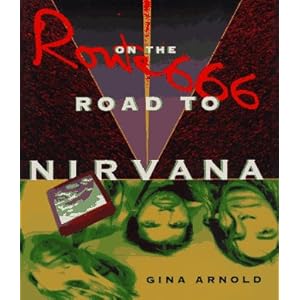In the fifteen years or so since 666: On The Road To Nirvana was published, the reaction to the name "Gina Arnold" still ranges from mild contempt to, well, this . A lot of the criticism is valid: her book is gushy, disjointed, and suspiciously devoid of female artists. (So is Michael Azerrad's highly praised book, Our Band Could Be Your Life . Maybe even more so, but that's an argument for a different day.) But back in the dark ages before music blogs, fan pages, and when independently produced magazines were hard to find outside my mid-sized Midwestern city's enclave of cool, it was fun to read a chummy, fangirl account of all those bands I was supposed to be grooving to, rather than a pedantic tome about Dylan (or insert your sacred cow here).
A book so routinely criticized for is its writer's purported friendships with the bands she wrote about, and for her place in the "scene" needs an equally solipsistic review: I like this book. I like it because I was that girl who navigated the world through music, and went gaga over far too many cute boys with messy hair and loud guitars. I hope I've become a more critical thinker since then, as I suspect Gina Arnold has since she wrote 666. But it still stands as one of the first books I read that hit me at precisely the right time.


There are few female artists in my book and Gina's book simply because there were few female artists in that scene. It's not some kind of vast sexist conspiracy, it's just the way it was. To portray it otherwise would have been to distort reality. I'm glad things have changed in the intervening years.
ReplyDeletePoint well taken. The female-fronted bands from that era that spring to mind, say, Throwing Muses, Blake Babies, or lesser known artists Vanessa Briscoe from Pylon probably don't spring to mind when you think of 80s indie rock.
ReplyDelete